University Cloud Computing: Digital Forensic Analysis Report
VerifiedAdded on 2022/08/26
|14
|3819
|28
Report
AI Summary
This report provides a comprehensive overview of digital forensics in cloud computing. It begins with an introduction to cloud computing and its characteristics, followed by an examination of different cloud computing types (private, public, and hybrid). The report then delves into the challenges faced by digital forensics in the cloud, such as data decentralization, lack of control, and customer awareness. It also explores the layers of cloud computing, including IaaS, PaaS, and SaaS, and discusses digital forensics within the SaaS service model, highlighting the relationships between CSP, CSN, and CSC. The report concludes with a discussion of future improvements and recommendations to enhance digital forensic capabilities in cloud environments. The report also contains the model for cloud forensics in the SaaS application.
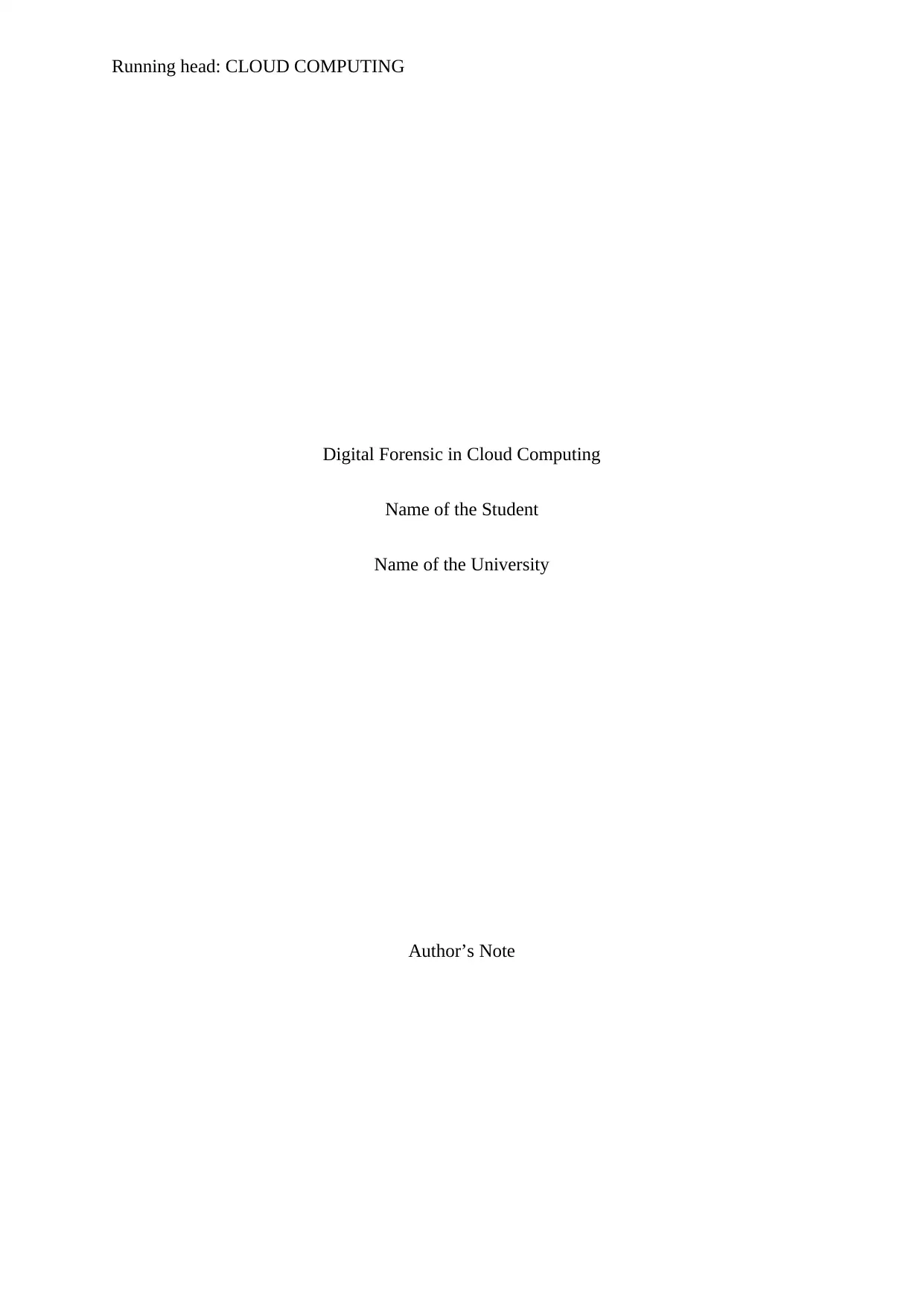
Running head: CLOUD COMPUTING
Digital Forensic in Cloud Computing
Name of the Student
Name of the University
Author’s Note
Digital Forensic in Cloud Computing
Name of the Student
Name of the University
Author’s Note
Paraphrase This Document
Need a fresh take? Get an instant paraphrase of this document with our AI Paraphraser
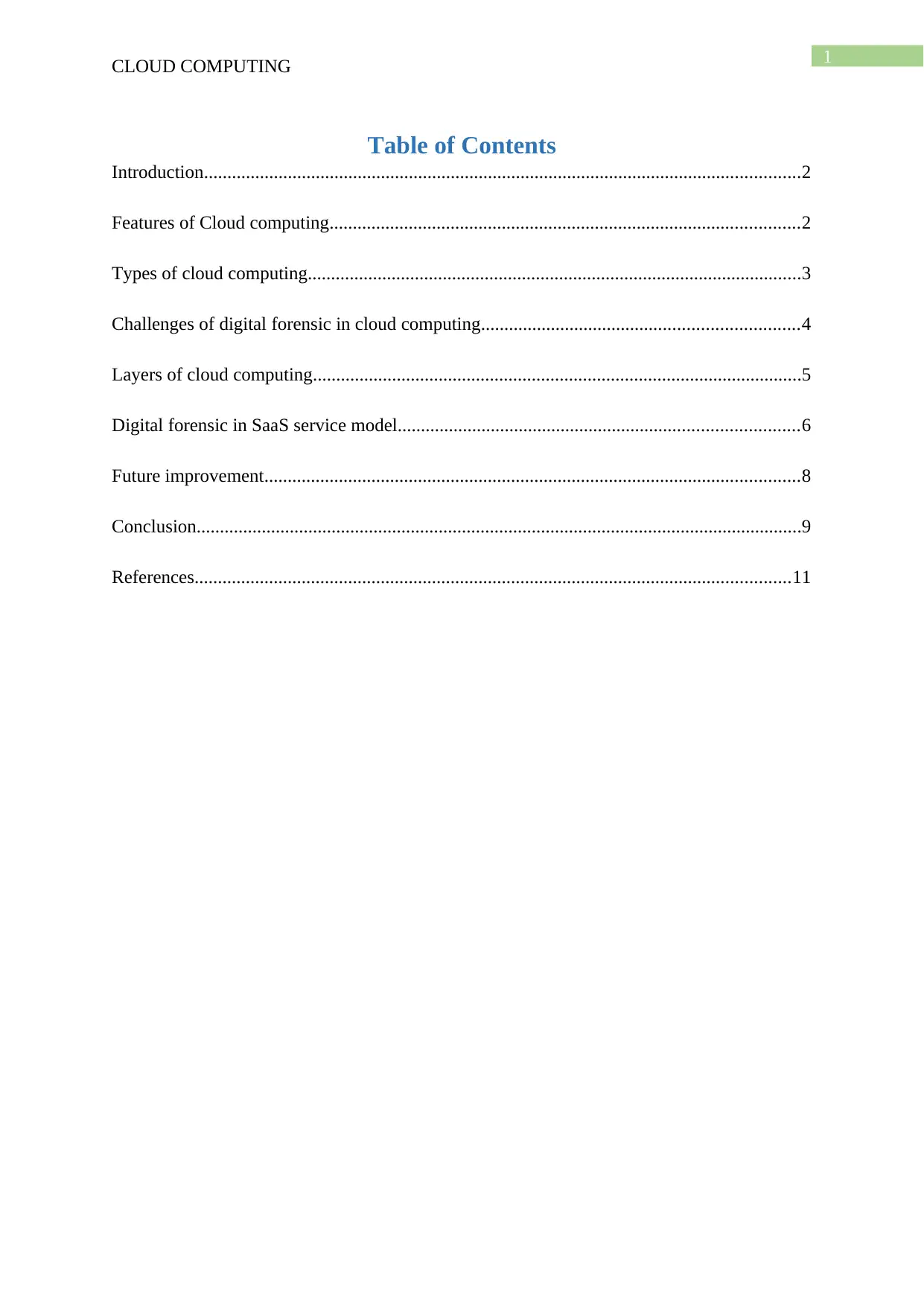
1
CLOUD COMPUTING
Table of Contents
Introduction................................................................................................................................2
Features of Cloud computing.....................................................................................................2
Types of cloud computing..........................................................................................................3
Challenges of digital forensic in cloud computing....................................................................4
Layers of cloud computing.........................................................................................................5
Digital forensic in SaaS service model......................................................................................6
Future improvement...................................................................................................................8
Conclusion..................................................................................................................................9
References................................................................................................................................11
CLOUD COMPUTING
Table of Contents
Introduction................................................................................................................................2
Features of Cloud computing.....................................................................................................2
Types of cloud computing..........................................................................................................3
Challenges of digital forensic in cloud computing....................................................................4
Layers of cloud computing.........................................................................................................5
Digital forensic in SaaS service model......................................................................................6
Future improvement...................................................................................................................8
Conclusion..................................................................................................................................9
References................................................................................................................................11
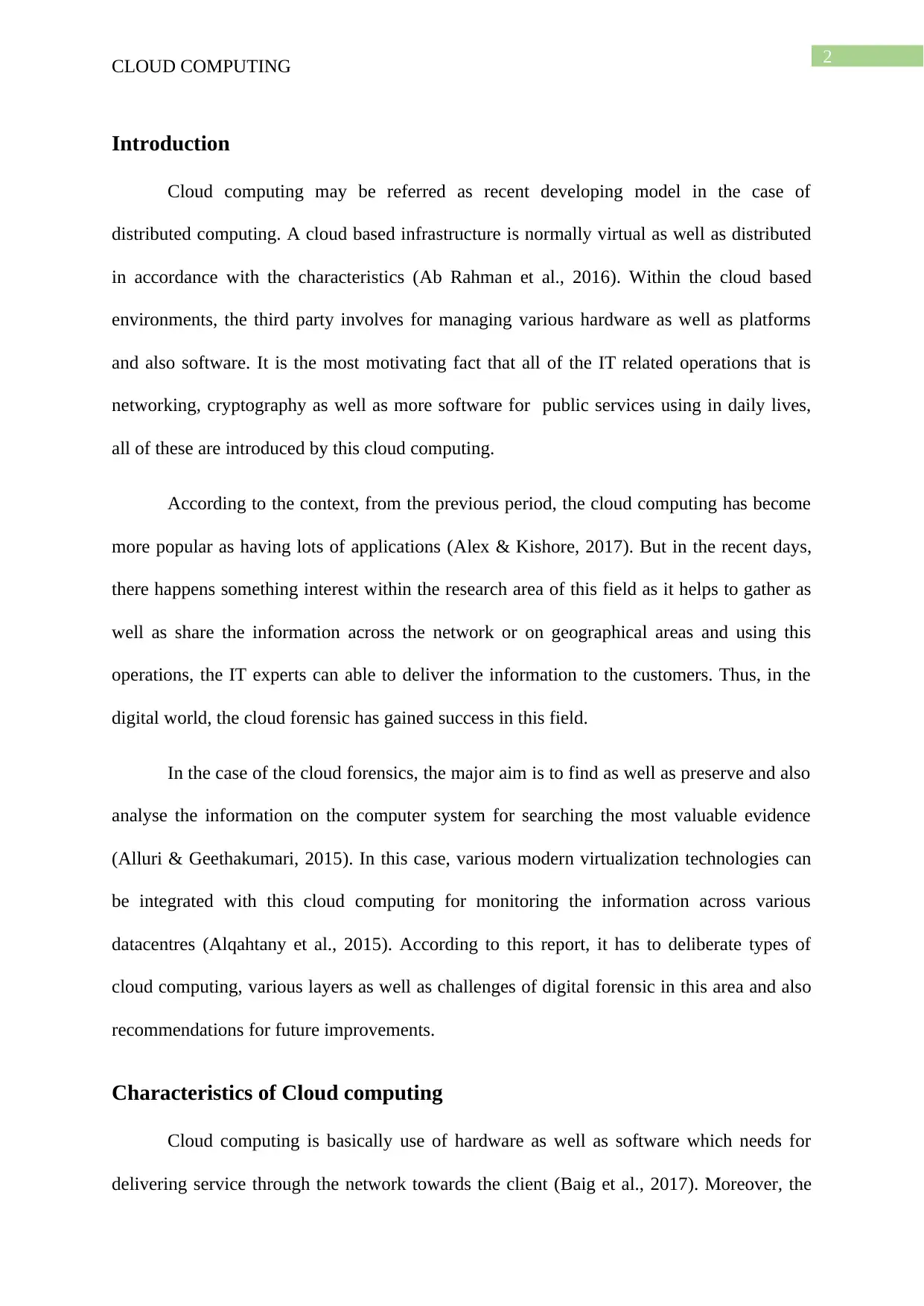
2
CLOUD COMPUTING
Introduction
Cloud computing may be referred as recent developing model in the case of
distributed computing. A cloud based infrastructure is normally virtual as well as distributed
in accordance with the characteristics (Ab Rahman et al., 2016). Within the cloud based
environments, the third party involves for managing various hardware as well as platforms
and also software. It is the most motivating fact that all of the IT related operations that is
networking, cryptography as well as more software for public services using in daily lives,
all of these are introduced by this cloud computing.
According to the context, from the previous period, the cloud computing has become
more popular as having lots of applications (Alex & Kishore, 2017). But in the recent days,
there happens something interest within the research area of this field as it helps to gather as
well as share the information across the network or on geographical areas and using this
operations, the IT experts can able to deliver the information to the customers. Thus, in the
digital world, the cloud forensic has gained success in this field.
In the case of the cloud forensics, the major aim is to find as well as preserve and also
analyse the information on the computer system for searching the most valuable evidence
(Alluri & Geethakumari, 2015). In this case, various modern virtualization technologies can
be integrated with this cloud computing for monitoring the information across various
datacentres (Alqahtany et al., 2015). According to this report, it has to deliberate types of
cloud computing, various layers as well as challenges of digital forensic in this area and also
recommendations for future improvements.
Characteristics of Cloud computing
Cloud computing is basically use of hardware as well as software which needs for
delivering service through the network towards the client (Baig et al., 2017). Moreover, the
CLOUD COMPUTING
Introduction
Cloud computing may be referred as recent developing model in the case of
distributed computing. A cloud based infrastructure is normally virtual as well as distributed
in accordance with the characteristics (Ab Rahman et al., 2016). Within the cloud based
environments, the third party involves for managing various hardware as well as platforms
and also software. It is the most motivating fact that all of the IT related operations that is
networking, cryptography as well as more software for public services using in daily lives,
all of these are introduced by this cloud computing.
According to the context, from the previous period, the cloud computing has become
more popular as having lots of applications (Alex & Kishore, 2017). But in the recent days,
there happens something interest within the research area of this field as it helps to gather as
well as share the information across the network or on geographical areas and using this
operations, the IT experts can able to deliver the information to the customers. Thus, in the
digital world, the cloud forensic has gained success in this field.
In the case of the cloud forensics, the major aim is to find as well as preserve and also
analyse the information on the computer system for searching the most valuable evidence
(Alluri & Geethakumari, 2015). In this case, various modern virtualization technologies can
be integrated with this cloud computing for monitoring the information across various
datacentres (Alqahtany et al., 2015). According to this report, it has to deliberate types of
cloud computing, various layers as well as challenges of digital forensic in this area and also
recommendations for future improvements.
Characteristics of Cloud computing
Cloud computing is basically use of hardware as well as software which needs for
delivering service through the network towards the client (Baig et al., 2017). Moreover, the
⊘ This is a preview!⊘
Do you want full access?
Subscribe today to unlock all pages.

Trusted by 1+ million students worldwide
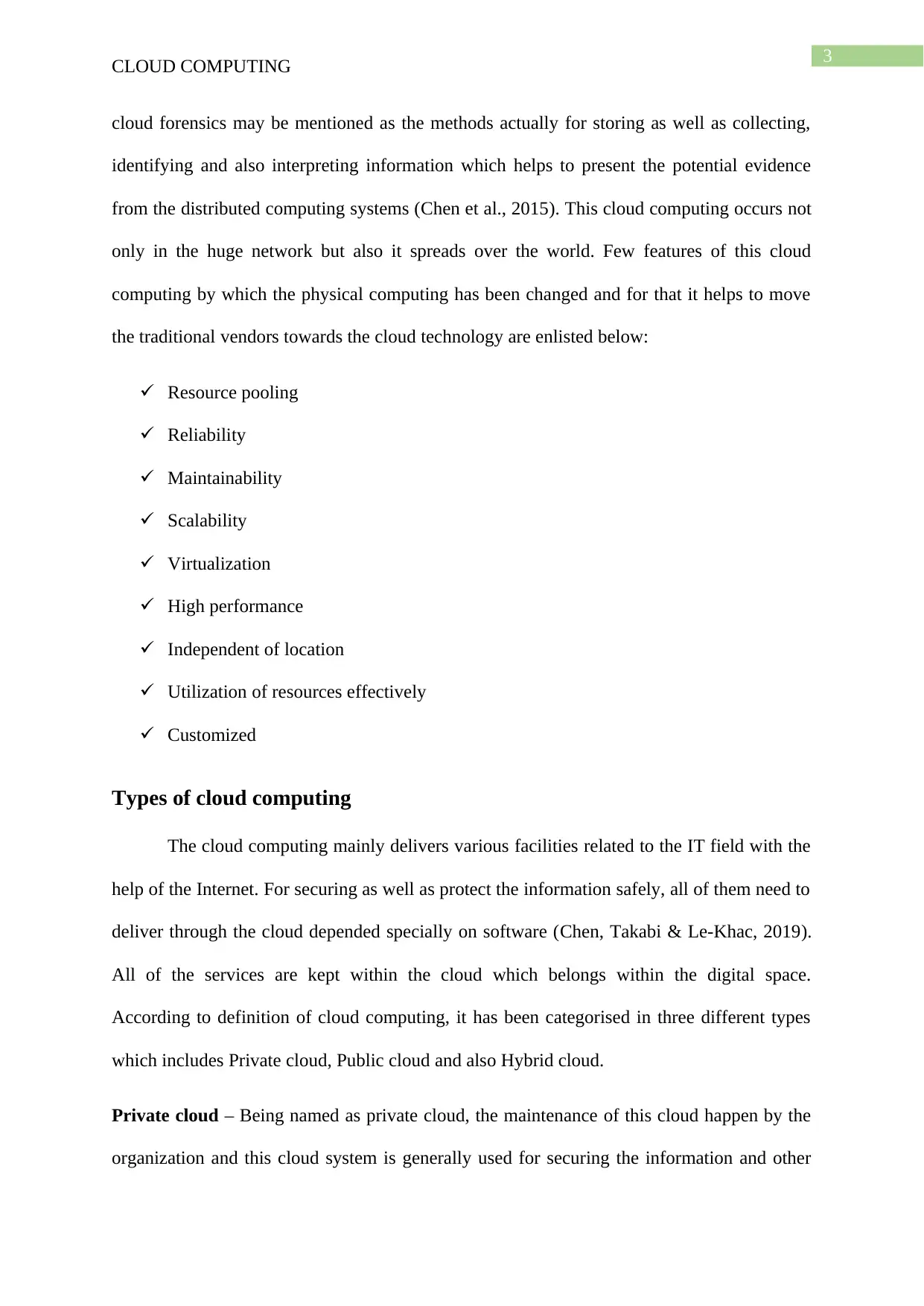
3
CLOUD COMPUTING
cloud forensics may be mentioned as the methods actually for storing as well as collecting,
identifying and also interpreting information which helps to present the potential evidence
from the distributed computing systems (Chen et al., 2015). This cloud computing occurs not
only in the huge network but also it spreads over the world. Few features of this cloud
computing by which the physical computing has been changed and for that it helps to move
the traditional vendors towards the cloud technology are enlisted below:
Resource pooling
Reliability
Maintainability
Scalability
Virtualization
High performance
Independent of location
Utilization of resources effectively
Customized
Types of cloud computing
The cloud computing mainly delivers various facilities related to the IT field with the
help of the Internet. For securing as well as protect the information safely, all of them need to
deliver through the cloud depended specially on software (Chen, Takabi & Le-Khac, 2019).
All of the services are kept within the cloud which belongs within the digital space.
According to definition of cloud computing, it has been categorised in three different types
which includes Private cloud, Public cloud and also Hybrid cloud.
Private cloud – Being named as private cloud, the maintenance of this cloud happen by the
organization and this cloud system is generally used for securing the information and other
CLOUD COMPUTING
cloud forensics may be mentioned as the methods actually for storing as well as collecting,
identifying and also interpreting information which helps to present the potential evidence
from the distributed computing systems (Chen et al., 2015). This cloud computing occurs not
only in the huge network but also it spreads over the world. Few features of this cloud
computing by which the physical computing has been changed and for that it helps to move
the traditional vendors towards the cloud technology are enlisted below:
Resource pooling
Reliability
Maintainability
Scalability
Virtualization
High performance
Independent of location
Utilization of resources effectively
Customized
Types of cloud computing
The cloud computing mainly delivers various facilities related to the IT field with the
help of the Internet. For securing as well as protect the information safely, all of them need to
deliver through the cloud depended specially on software (Chen, Takabi & Le-Khac, 2019).
All of the services are kept within the cloud which belongs within the digital space.
According to definition of cloud computing, it has been categorised in three different types
which includes Private cloud, Public cloud and also Hybrid cloud.
Private cloud – Being named as private cloud, the maintenance of this cloud happen by the
organization and this cloud system is generally used for securing the information and other
Paraphrase This Document
Need a fresh take? Get an instant paraphrase of this document with our AI Paraphraser
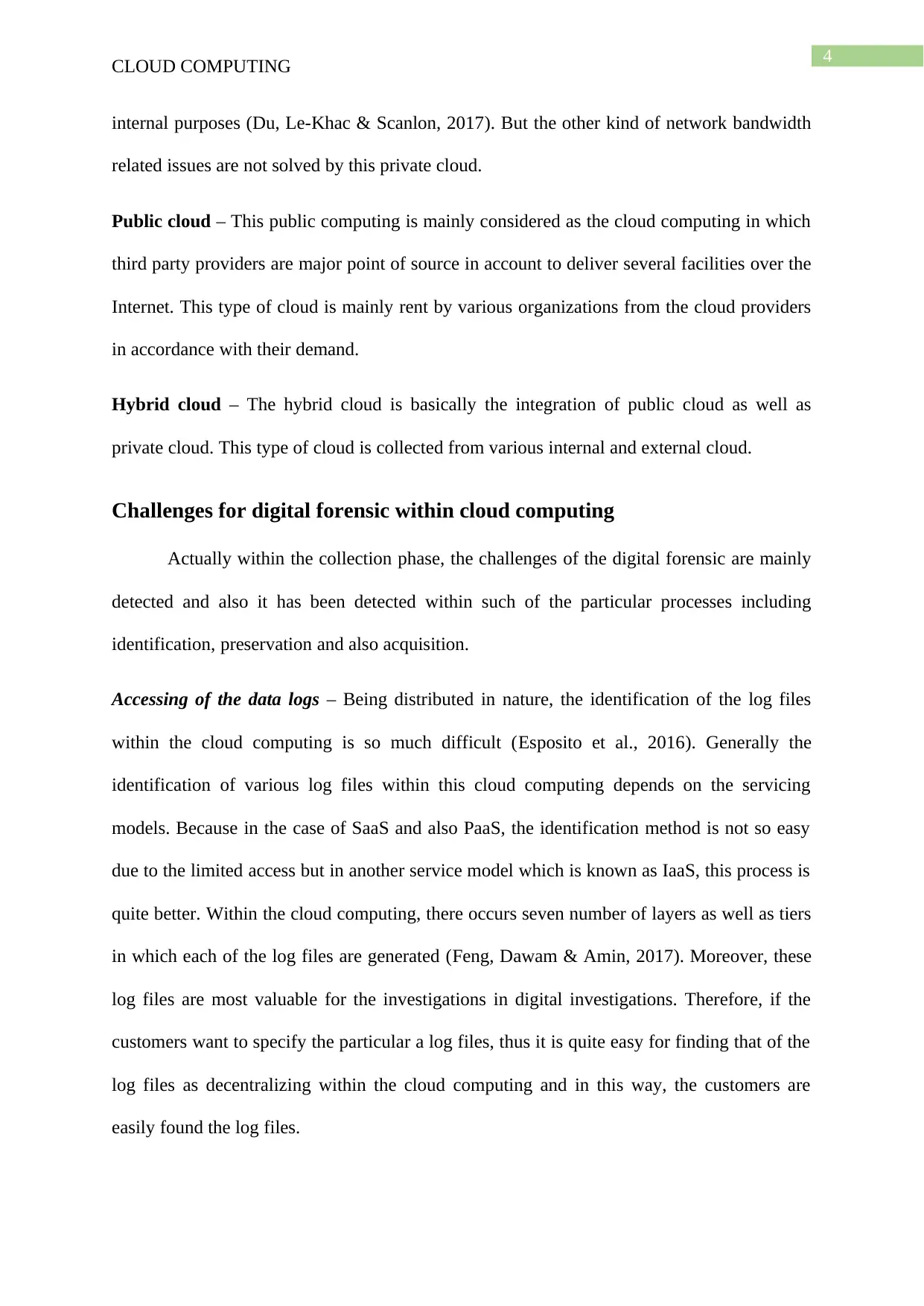
4
CLOUD COMPUTING
internal purposes (Du, Le-Khac & Scanlon, 2017). But the other kind of network bandwidth
related issues are not solved by this private cloud.
Public cloud – This public computing is mainly considered as the cloud computing in which
third party providers are major point of source in account to deliver several facilities over the
Internet. This type of cloud is mainly rent by various organizations from the cloud providers
in accordance with their demand.
Hybrid cloud – The hybrid cloud is basically the integration of public cloud as well as
private cloud. This type of cloud is collected from various internal and external cloud.
Challenges for digital forensic within cloud computing
Actually within the collection phase, the challenges of the digital forensic are mainly
detected and also it has been detected within such of the particular processes including
identification, preservation and also acquisition.
Accessing of the data logs – Being distributed in nature, the identification of the log files
within the cloud computing is so much difficult (Esposito et al., 2016). Generally the
identification of various log files within this cloud computing depends on the servicing
models. Because in the case of SaaS and also PaaS, the identification method is not so easy
due to the limited access but in another service model which is known as IaaS, this process is
quite better. Within the cloud computing, there occurs seven number of layers as well as tiers
in which each of the log files are generated (Feng, Dawam & Amin, 2017). Moreover, these
log files are most valuable for the investigations in digital investigations. Therefore, if the
customers want to specify the particular a log files, thus it is quite easy for finding that of the
log files as decentralizing within the cloud computing and in this way, the customers are
easily found the log files.
CLOUD COMPUTING
internal purposes (Du, Le-Khac & Scanlon, 2017). But the other kind of network bandwidth
related issues are not solved by this private cloud.
Public cloud – This public computing is mainly considered as the cloud computing in which
third party providers are major point of source in account to deliver several facilities over the
Internet. This type of cloud is mainly rent by various organizations from the cloud providers
in accordance with their demand.
Hybrid cloud – The hybrid cloud is basically the integration of public cloud as well as
private cloud. This type of cloud is collected from various internal and external cloud.
Challenges for digital forensic within cloud computing
Actually within the collection phase, the challenges of the digital forensic are mainly
detected and also it has been detected within such of the particular processes including
identification, preservation and also acquisition.
Accessing of the data logs – Being distributed in nature, the identification of the log files
within the cloud computing is so much difficult (Esposito et al., 2016). Generally the
identification of various log files within this cloud computing depends on the servicing
models. Because in the case of SaaS and also PaaS, the identification method is not so easy
due to the limited access but in another service model which is known as IaaS, this process is
quite better. Within the cloud computing, there occurs seven number of layers as well as tiers
in which each of the log files are generated (Feng, Dawam & Amin, 2017). Moreover, these
log files are most valuable for the investigations in digital investigations. Therefore, if the
customers want to specify the particular a log files, thus it is quite easy for finding that of the
log files as decentralizing within the cloud computing and in this way, the customers are
easily found the log files.
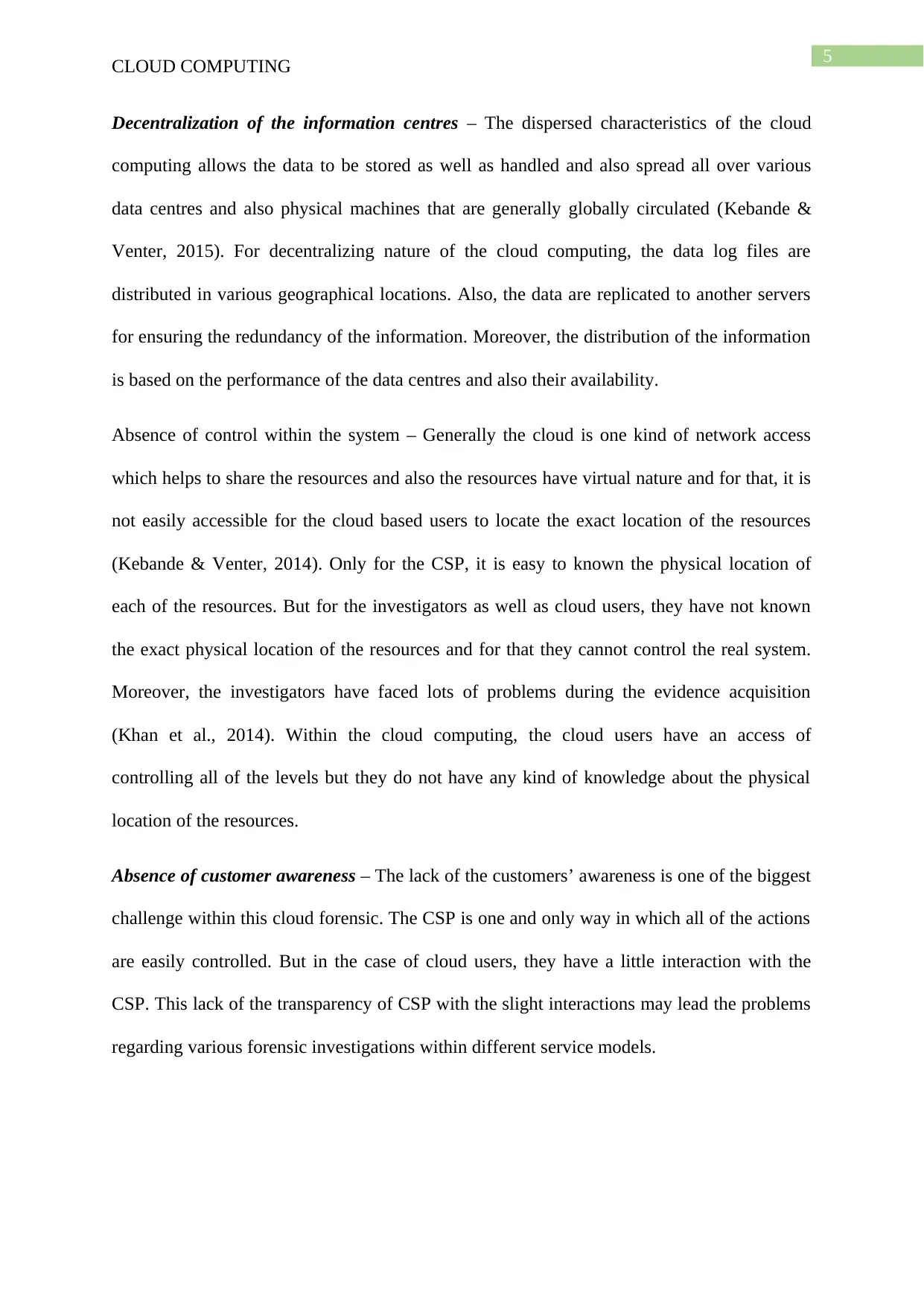
5
CLOUD COMPUTING
Decentralization of the information centres – The dispersed characteristics of the cloud
computing allows the data to be stored as well as handled and also spread all over various
data centres and also physical machines that are generally globally circulated (Kebande &
Venter, 2015). For decentralizing nature of the cloud computing, the data log files are
distributed in various geographical locations. Also, the data are replicated to another servers
for ensuring the redundancy of the information. Moreover, the distribution of the information
is based on the performance of the data centres and also their availability.
Absence of control within the system – Generally the cloud is one kind of network access
which helps to share the resources and also the resources have virtual nature and for that, it is
not easily accessible for the cloud based users to locate the exact location of the resources
(Kebande & Venter, 2014). Only for the CSP, it is easy to known the physical location of
each of the resources. But for the investigators as well as cloud users, they have not known
the exact physical location of the resources and for that they cannot control the real system.
Moreover, the investigators have faced lots of problems during the evidence acquisition
(Khan et al., 2014). Within the cloud computing, the cloud users have an access of
controlling all of the levels but they do not have any kind of knowledge about the physical
location of the resources.
Absence of customer awareness – The lack of the customers’ awareness is one of the biggest
challenge within this cloud forensic. The CSP is one and only way in which all of the actions
are easily controlled. But in the case of cloud users, they have a little interaction with the
CSP. This lack of the transparency of CSP with the slight interactions may lead the problems
regarding various forensic investigations within different service models.
CLOUD COMPUTING
Decentralization of the information centres – The dispersed characteristics of the cloud
computing allows the data to be stored as well as handled and also spread all over various
data centres and also physical machines that are generally globally circulated (Kebande &
Venter, 2015). For decentralizing nature of the cloud computing, the data log files are
distributed in various geographical locations. Also, the data are replicated to another servers
for ensuring the redundancy of the information. Moreover, the distribution of the information
is based on the performance of the data centres and also their availability.
Absence of control within the system – Generally the cloud is one kind of network access
which helps to share the resources and also the resources have virtual nature and for that, it is
not easily accessible for the cloud based users to locate the exact location of the resources
(Kebande & Venter, 2014). Only for the CSP, it is easy to known the physical location of
each of the resources. But for the investigators as well as cloud users, they have not known
the exact physical location of the resources and for that they cannot control the real system.
Moreover, the investigators have faced lots of problems during the evidence acquisition
(Khan et al., 2014). Within the cloud computing, the cloud users have an access of
controlling all of the levels but they do not have any kind of knowledge about the physical
location of the resources.
Absence of customer awareness – The lack of the customers’ awareness is one of the biggest
challenge within this cloud forensic. The CSP is one and only way in which all of the actions
are easily controlled. But in the case of cloud users, they have a little interaction with the
CSP. This lack of the transparency of CSP with the slight interactions may lead the problems
regarding various forensic investigations within different service models.
⊘ This is a preview!⊘
Do you want full access?
Subscribe today to unlock all pages.

Trusted by 1+ million students worldwide
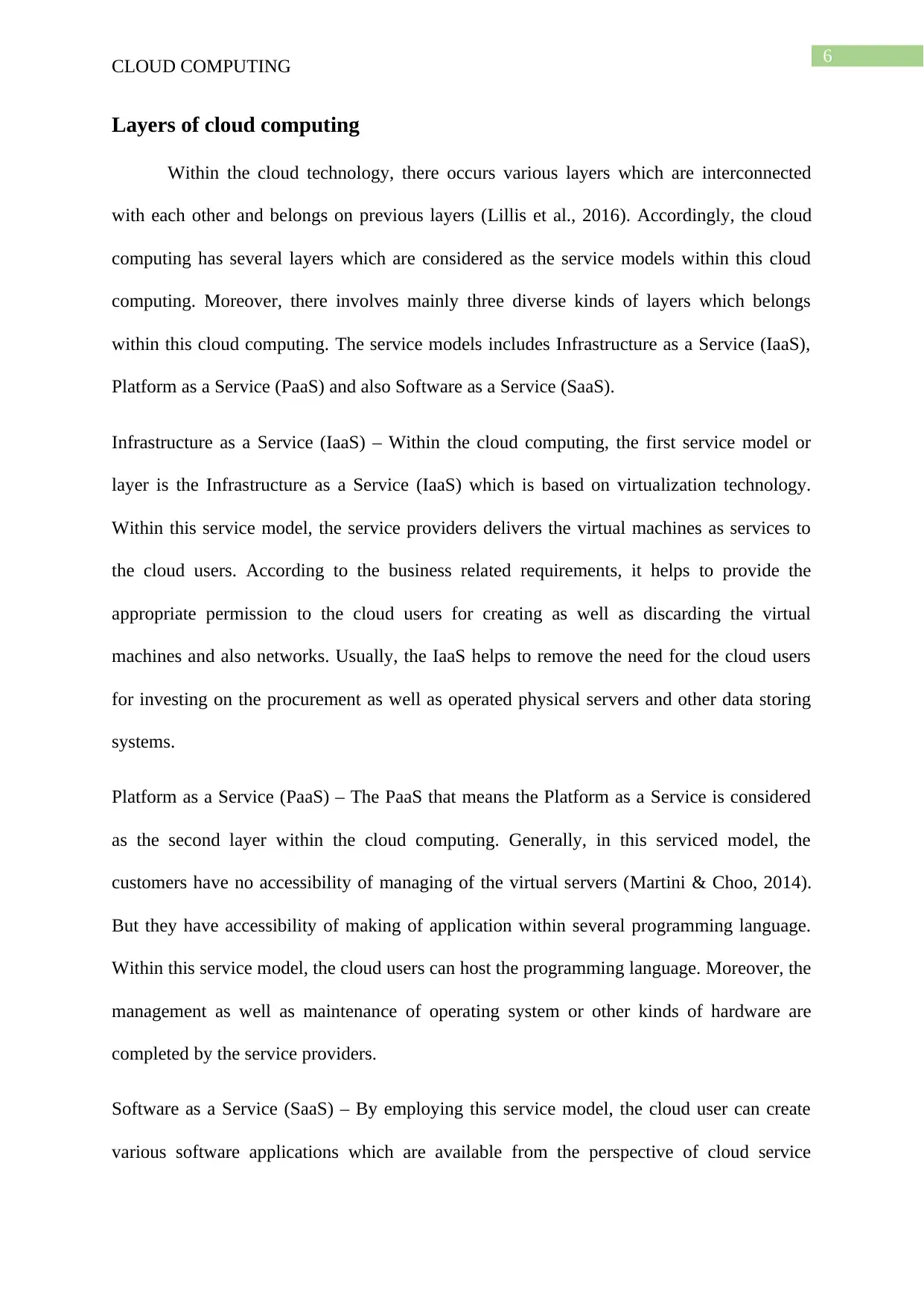
6
CLOUD COMPUTING
Layers of cloud computing
Within the cloud technology, there occurs various layers which are interconnected
with each other and belongs on previous layers (Lillis et al., 2016). Accordingly, the cloud
computing has several layers which are considered as the service models within this cloud
computing. Moreover, there involves mainly three diverse kinds of layers which belongs
within this cloud computing. The service models includes Infrastructure as a Service (IaaS),
Platform as a Service (PaaS) and also Software as a Service (SaaS).
Infrastructure as a Service (IaaS) – Within the cloud computing, the first service model or
layer is the Infrastructure as a Service (IaaS) which is based on virtualization technology.
Within this service model, the service providers delivers the virtual machines as services to
the cloud users. According to the business related requirements, it helps to provide the
appropriate permission to the cloud users for creating as well as discarding the virtual
machines and also networks. Usually, the IaaS helps to remove the need for the cloud users
for investing on the procurement as well as operated physical servers and other data storing
systems.
Platform as a Service (PaaS) – The PaaS that means the Platform as a Service is considered
as the second layer within the cloud computing. Generally, in this serviced model, the
customers have no accessibility of managing of the virtual servers (Martini & Choo, 2014).
But they have accessibility of making of application within several programming language.
Within this service model, the cloud users can host the programming language. Moreover, the
management as well as maintenance of operating system or other kinds of hardware are
completed by the service providers.
Software as a Service (SaaS) – By employing this service model, the cloud user can create
various software applications which are available from the perspective of cloud service
CLOUD COMPUTING
Layers of cloud computing
Within the cloud technology, there occurs various layers which are interconnected
with each other and belongs on previous layers (Lillis et al., 2016). Accordingly, the cloud
computing has several layers which are considered as the service models within this cloud
computing. Moreover, there involves mainly three diverse kinds of layers which belongs
within this cloud computing. The service models includes Infrastructure as a Service (IaaS),
Platform as a Service (PaaS) and also Software as a Service (SaaS).
Infrastructure as a Service (IaaS) – Within the cloud computing, the first service model or
layer is the Infrastructure as a Service (IaaS) which is based on virtualization technology.
Within this service model, the service providers delivers the virtual machines as services to
the cloud users. According to the business related requirements, it helps to provide the
appropriate permission to the cloud users for creating as well as discarding the virtual
machines and also networks. Usually, the IaaS helps to remove the need for the cloud users
for investing on the procurement as well as operated physical servers and other data storing
systems.
Platform as a Service (PaaS) – The PaaS that means the Platform as a Service is considered
as the second layer within the cloud computing. Generally, in this serviced model, the
customers have no accessibility of managing of the virtual servers (Martini & Choo, 2014).
But they have accessibility of making of application within several programming language.
Within this service model, the cloud users can host the programming language. Moreover, the
management as well as maintenance of operating system or other kinds of hardware are
completed by the service providers.
Software as a Service (SaaS) – By employing this service model, the cloud user can create
various software applications which are available from the perspective of cloud service
Paraphrase This Document
Need a fresh take? Get an instant paraphrase of this document with our AI Paraphraser
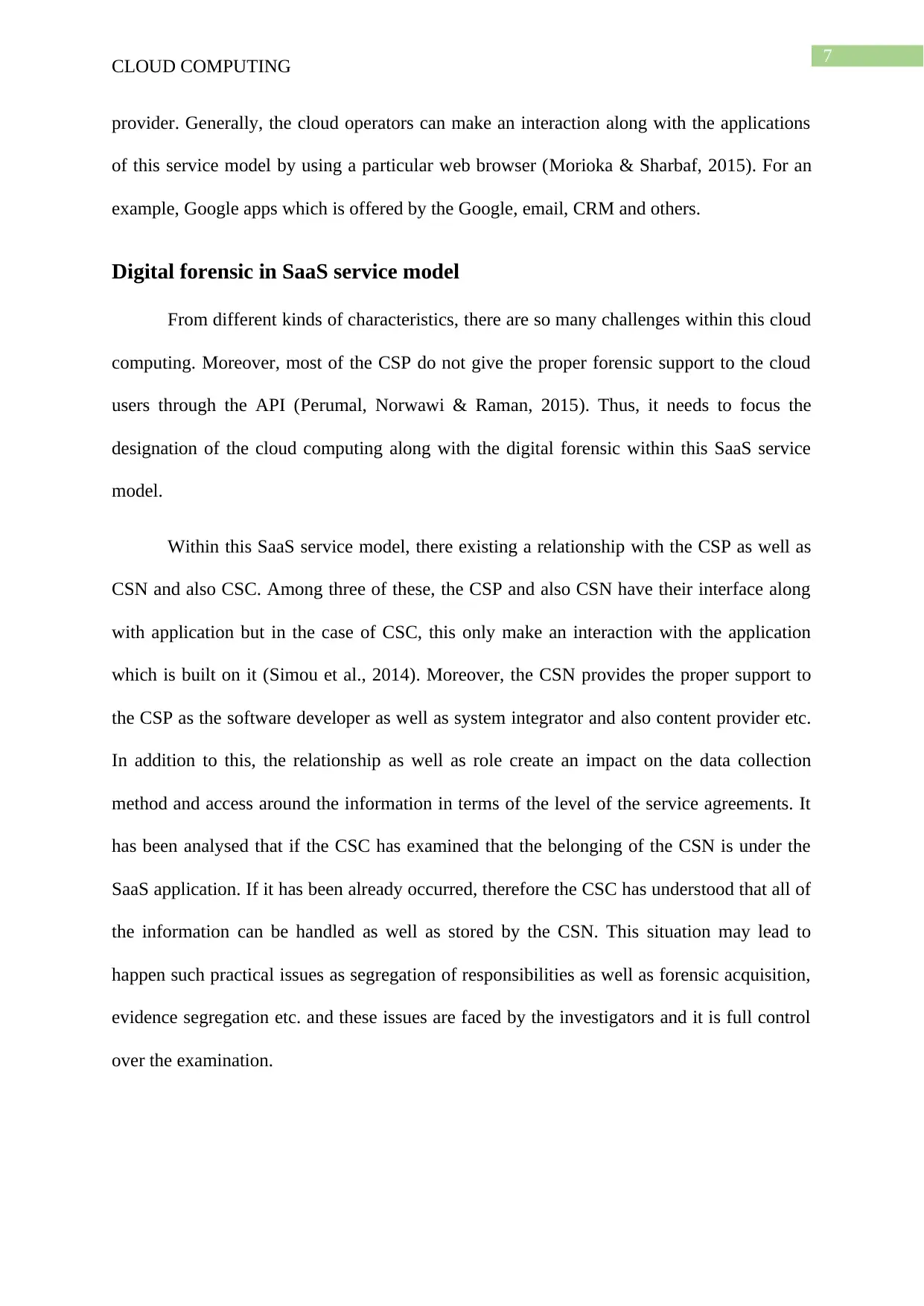
7
CLOUD COMPUTING
provider. Generally, the cloud operators can make an interaction along with the applications
of this service model by using a particular web browser (Morioka & Sharbaf, 2015). For an
example, Google apps which is offered by the Google, email, CRM and others.
Digital forensic in SaaS service model
From different kinds of characteristics, there are so many challenges within this cloud
computing. Moreover, most of the CSP do not give the proper forensic support to the cloud
users through the API (Perumal, Norwawi & Raman, 2015). Thus, it needs to focus the
designation of the cloud computing along with the digital forensic within this SaaS service
model.
Within this SaaS service model, there existing a relationship with the CSP as well as
CSN and also CSC. Among three of these, the CSP and also CSN have their interface along
with application but in the case of CSC, this only make an interaction with the application
which is built on it (Simou et al., 2014). Moreover, the CSN provides the proper support to
the CSP as the software developer as well as system integrator and also content provider etc.
In addition to this, the relationship as well as role create an impact on the data collection
method and access around the information in terms of the level of the service agreements. It
has been analysed that if the CSC has examined that the belonging of the CSN is under the
SaaS application. If it has been already occurred, therefore the CSC has understood that all of
the information can be handled as well as stored by the CSN. This situation may lead to
happen such practical issues as segregation of responsibilities as well as forensic acquisition,
evidence segregation etc. and these issues are faced by the investigators and it is full control
over the examination.
CLOUD COMPUTING
provider. Generally, the cloud operators can make an interaction along with the applications
of this service model by using a particular web browser (Morioka & Sharbaf, 2015). For an
example, Google apps which is offered by the Google, email, CRM and others.
Digital forensic in SaaS service model
From different kinds of characteristics, there are so many challenges within this cloud
computing. Moreover, most of the CSP do not give the proper forensic support to the cloud
users through the API (Perumal, Norwawi & Raman, 2015). Thus, it needs to focus the
designation of the cloud computing along with the digital forensic within this SaaS service
model.
Within this SaaS service model, there existing a relationship with the CSP as well as
CSN and also CSC. Among three of these, the CSP and also CSN have their interface along
with application but in the case of CSC, this only make an interaction with the application
which is built on it (Simou et al., 2014). Moreover, the CSN provides the proper support to
the CSP as the software developer as well as system integrator and also content provider etc.
In addition to this, the relationship as well as role create an impact on the data collection
method and access around the information in terms of the level of the service agreements. It
has been analysed that if the CSC has examined that the belonging of the CSN is under the
SaaS application. If it has been already occurred, therefore the CSC has understood that all of
the information can be handled as well as stored by the CSN. This situation may lead to
happen such practical issues as segregation of responsibilities as well as forensic acquisition,
evidence segregation etc. and these issues are faced by the investigators and it is full control
over the examination.
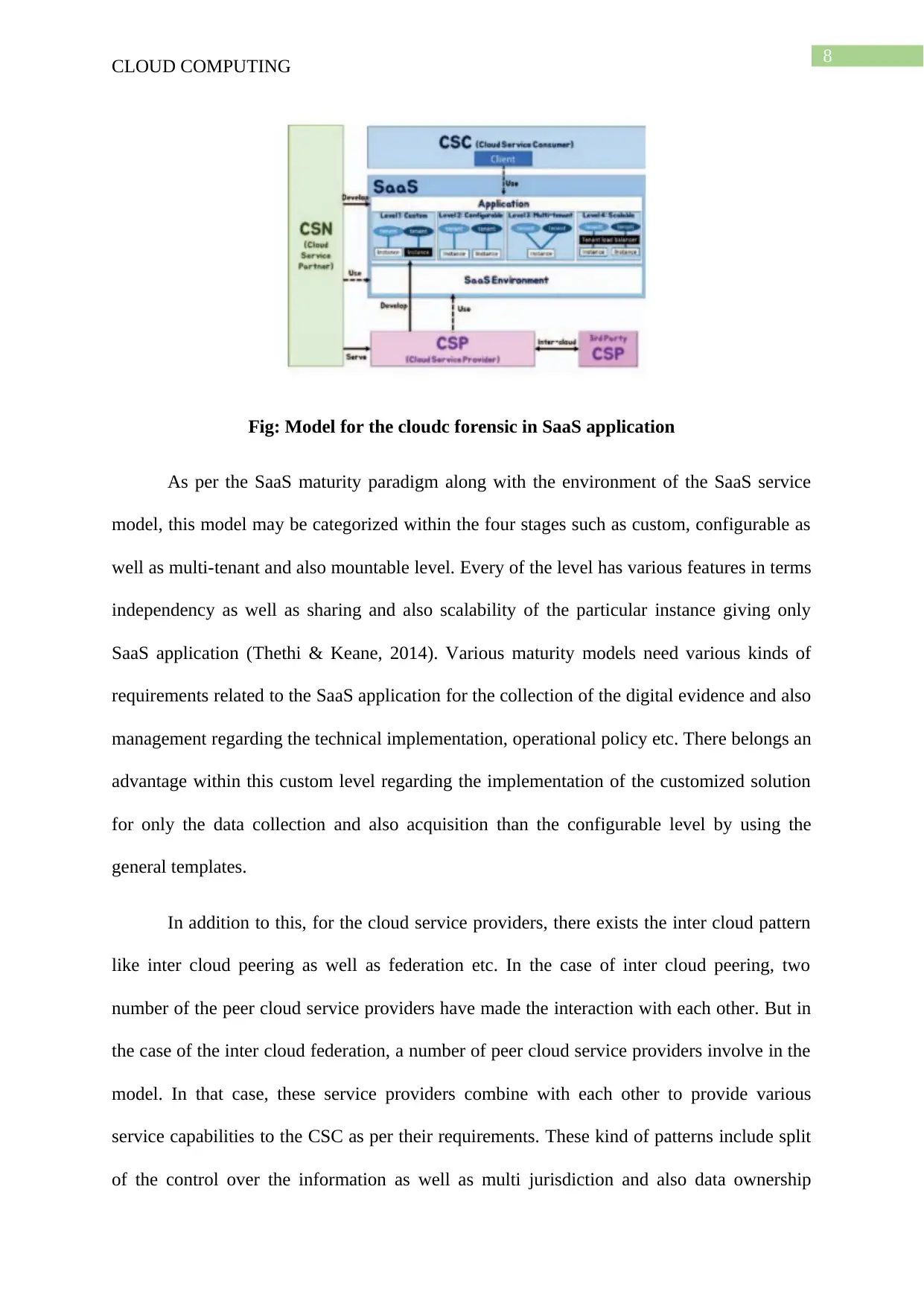
8
CLOUD COMPUTING
Fig: Model for the cloudc forensic in SaaS application
As per the SaaS maturity paradigm along with the environment of the SaaS service
model, this model may be categorized within the four stages such as custom, configurable as
well as multi-tenant and also mountable level. Every of the level has various features in terms
independency as well as sharing and also scalability of the particular instance giving only
SaaS application (Thethi & Keane, 2014). Various maturity models need various kinds of
requirements related to the SaaS application for the collection of the digital evidence and also
management regarding the technical implementation, operational policy etc. There belongs an
advantage within this custom level regarding the implementation of the customized solution
for only the data collection and also acquisition than the configurable level by using the
general templates.
In addition to this, for the cloud service providers, there exists the inter cloud pattern
like inter cloud peering as well as federation etc. In the case of inter cloud peering, two
number of the peer cloud service providers have made the interaction with each other. But in
the case of the inter cloud federation, a number of peer cloud service providers involve in the
model. In that case, these service providers combine with each other to provide various
service capabilities to the CSC as per their requirements. These kind of patterns include split
of the control over the information as well as multi jurisdiction and also data ownership
CLOUD COMPUTING
Fig: Model for the cloudc forensic in SaaS application
As per the SaaS maturity paradigm along with the environment of the SaaS service
model, this model may be categorized within the four stages such as custom, configurable as
well as multi-tenant and also mountable level. Every of the level has various features in terms
independency as well as sharing and also scalability of the particular instance giving only
SaaS application (Thethi & Keane, 2014). Various maturity models need various kinds of
requirements related to the SaaS application for the collection of the digital evidence and also
management regarding the technical implementation, operational policy etc. There belongs an
advantage within this custom level regarding the implementation of the customized solution
for only the data collection and also acquisition than the configurable level by using the
general templates.
In addition to this, for the cloud service providers, there exists the inter cloud pattern
like inter cloud peering as well as federation etc. In the case of inter cloud peering, two
number of the peer cloud service providers have made the interaction with each other. But in
the case of the inter cloud federation, a number of peer cloud service providers involve in the
model. In that case, these service providers combine with each other to provide various
service capabilities to the CSC as per their requirements. These kind of patterns include split
of the control over the information as well as multi jurisdiction and also data ownership
⊘ This is a preview!⊘
Do you want full access?
Subscribe today to unlock all pages.

Trusted by 1+ million students worldwide
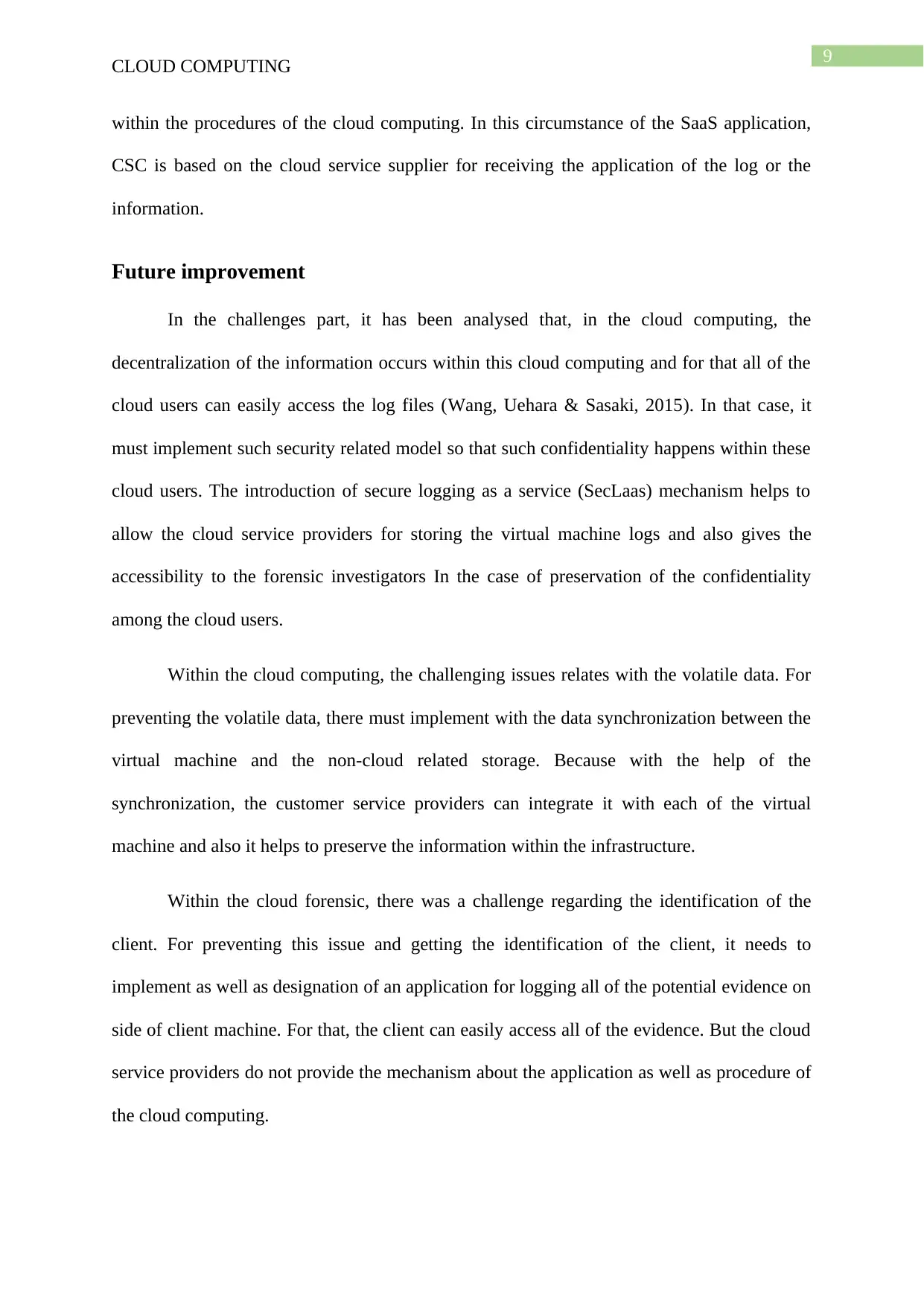
9
CLOUD COMPUTING
within the procedures of the cloud computing. In this circumstance of the SaaS application,
CSC is based on the cloud service supplier for receiving the application of the log or the
information.
Future improvement
In the challenges part, it has been analysed that, in the cloud computing, the
decentralization of the information occurs within this cloud computing and for that all of the
cloud users can easily access the log files (Wang, Uehara & Sasaki, 2015). In that case, it
must implement such security related model so that such confidentiality happens within these
cloud users. The introduction of secure logging as a service (SecLaas) mechanism helps to
allow the cloud service providers for storing the virtual machine logs and also gives the
accessibility to the forensic investigators In the case of preservation of the confidentiality
among the cloud users.
Within the cloud computing, the challenging issues relates with the volatile data. For
preventing the volatile data, there must implement with the data synchronization between the
virtual machine and the non-cloud related storage. Because with the help of the
synchronization, the customer service providers can integrate it with each of the virtual
machine and also it helps to preserve the information within the infrastructure.
Within the cloud forensic, there was a challenge regarding the identification of the
client. For preventing this issue and getting the identification of the client, it needs to
implement as well as designation of an application for logging all of the potential evidence on
side of client machine. For that, the client can easily access all of the evidence. But the cloud
service providers do not provide the mechanism about the application as well as procedure of
the cloud computing.
CLOUD COMPUTING
within the procedures of the cloud computing. In this circumstance of the SaaS application,
CSC is based on the cloud service supplier for receiving the application of the log or the
information.
Future improvement
In the challenges part, it has been analysed that, in the cloud computing, the
decentralization of the information occurs within this cloud computing and for that all of the
cloud users can easily access the log files (Wang, Uehara & Sasaki, 2015). In that case, it
must implement such security related model so that such confidentiality happens within these
cloud users. The introduction of secure logging as a service (SecLaas) mechanism helps to
allow the cloud service providers for storing the virtual machine logs and also gives the
accessibility to the forensic investigators In the case of preservation of the confidentiality
among the cloud users.
Within the cloud computing, the challenging issues relates with the volatile data. For
preventing the volatile data, there must implement with the data synchronization between the
virtual machine and the non-cloud related storage. Because with the help of the
synchronization, the customer service providers can integrate it with each of the virtual
machine and also it helps to preserve the information within the infrastructure.
Within the cloud forensic, there was a challenge regarding the identification of the
client. For preventing this issue and getting the identification of the client, it needs to
implement as well as designation of an application for logging all of the potential evidence on
side of client machine. For that, the client can easily access all of the evidence. But the cloud
service providers do not provide the mechanism about the application as well as procedure of
the cloud computing.
Paraphrase This Document
Need a fresh take? Get an instant paraphrase of this document with our AI Paraphraser
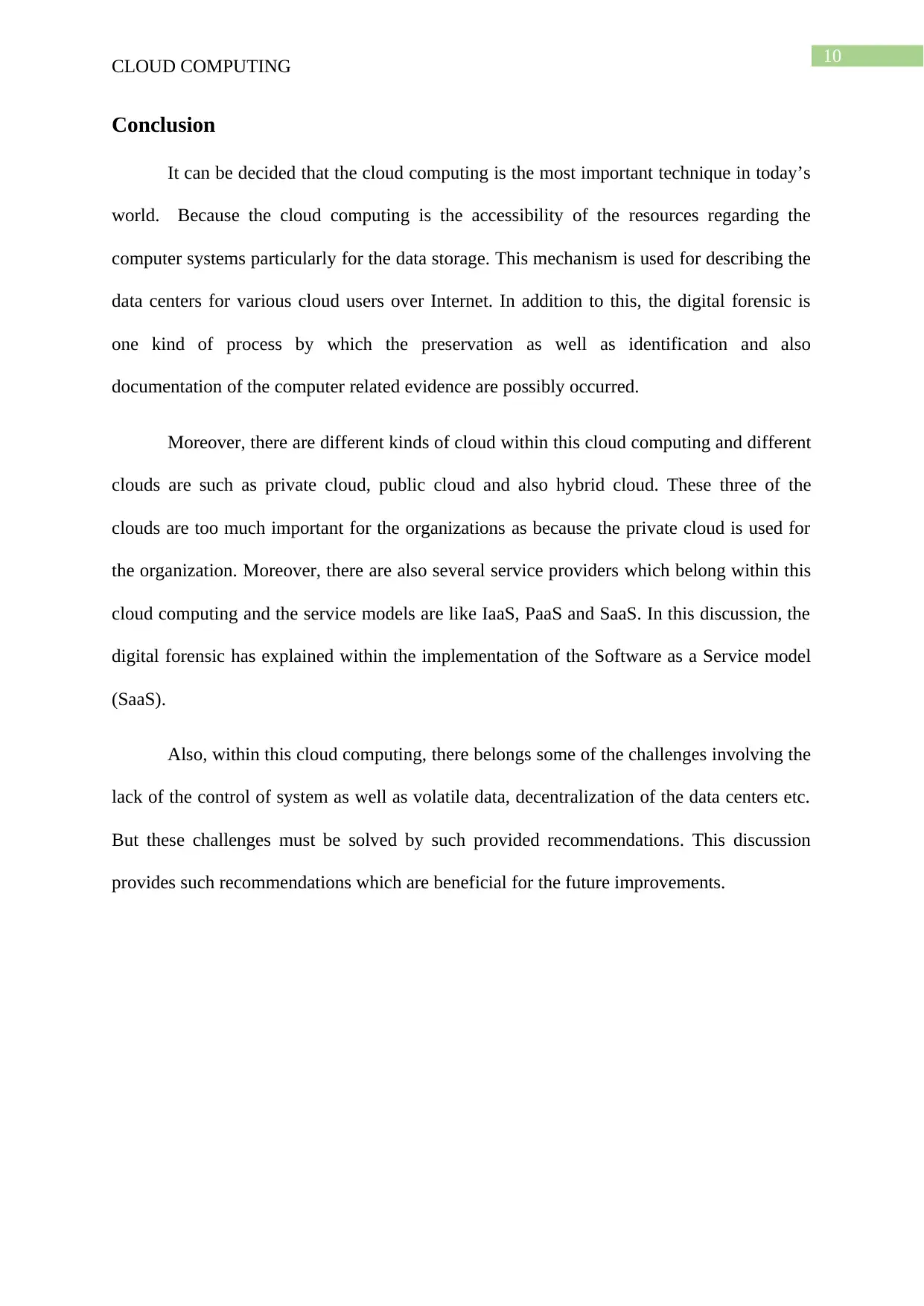
10
CLOUD COMPUTING
Conclusion
It can be decided that the cloud computing is the most important technique in today’s
world. Because the cloud computing is the accessibility of the resources regarding the
computer systems particularly for the data storage. This mechanism is used for describing the
data centers for various cloud users over Internet. In addition to this, the digital forensic is
one kind of process by which the preservation as well as identification and also
documentation of the computer related evidence are possibly occurred.
Moreover, there are different kinds of cloud within this cloud computing and different
clouds are such as private cloud, public cloud and also hybrid cloud. These three of the
clouds are too much important for the organizations as because the private cloud is used for
the organization. Moreover, there are also several service providers which belong within this
cloud computing and the service models are like IaaS, PaaS and SaaS. In this discussion, the
digital forensic has explained within the implementation of the Software as a Service model
(SaaS).
Also, within this cloud computing, there belongs some of the challenges involving the
lack of the control of system as well as volatile data, decentralization of the data centers etc.
But these challenges must be solved by such provided recommendations. This discussion
provides such recommendations which are beneficial for the future improvements.
CLOUD COMPUTING
Conclusion
It can be decided that the cloud computing is the most important technique in today’s
world. Because the cloud computing is the accessibility of the resources regarding the
computer systems particularly for the data storage. This mechanism is used for describing the
data centers for various cloud users over Internet. In addition to this, the digital forensic is
one kind of process by which the preservation as well as identification and also
documentation of the computer related evidence are possibly occurred.
Moreover, there are different kinds of cloud within this cloud computing and different
clouds are such as private cloud, public cloud and also hybrid cloud. These three of the
clouds are too much important for the organizations as because the private cloud is used for
the organization. Moreover, there are also several service providers which belong within this
cloud computing and the service models are like IaaS, PaaS and SaaS. In this discussion, the
digital forensic has explained within the implementation of the Software as a Service model
(SaaS).
Also, within this cloud computing, there belongs some of the challenges involving the
lack of the control of system as well as volatile data, decentralization of the data centers etc.
But these challenges must be solved by such provided recommendations. This discussion
provides such recommendations which are beneficial for the future improvements.
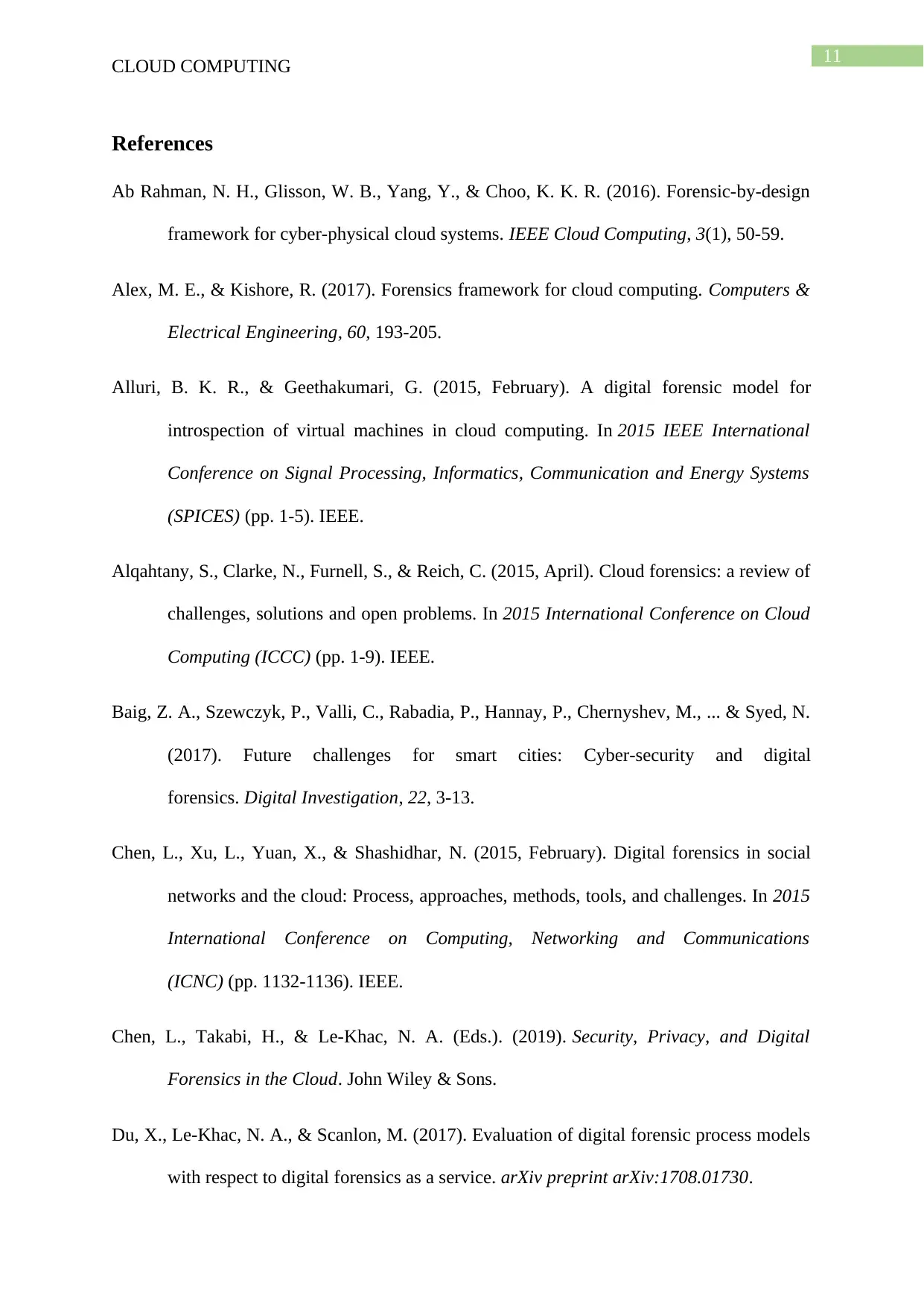
11
CLOUD COMPUTING
References
Ab Rahman, N. H., Glisson, W. B., Yang, Y., & Choo, K. K. R. (2016). Forensic-by-design
framework for cyber-physical cloud systems. IEEE Cloud Computing, 3(1), 50-59.
Alex, M. E., & Kishore, R. (2017). Forensics framework for cloud computing. Computers &
Electrical Engineering, 60, 193-205.
Alluri, B. K. R., & Geethakumari, G. (2015, February). A digital forensic model for
introspection of virtual machines in cloud computing. In 2015 IEEE International
Conference on Signal Processing, Informatics, Communication and Energy Systems
(SPICES) (pp. 1-5). IEEE.
Alqahtany, S., Clarke, N., Furnell, S., & Reich, C. (2015, April). Cloud forensics: a review of
challenges, solutions and open problems. In 2015 International Conference on Cloud
Computing (ICCC) (pp. 1-9). IEEE.
Baig, Z. A., Szewczyk, P., Valli, C., Rabadia, P., Hannay, P., Chernyshev, M., ... & Syed, N.
(2017). Future challenges for smart cities: Cyber-security and digital
forensics. Digital Investigation, 22, 3-13.
Chen, L., Xu, L., Yuan, X., & Shashidhar, N. (2015, February). Digital forensics in social
networks and the cloud: Process, approaches, methods, tools, and challenges. In 2015
International Conference on Computing, Networking and Communications
(ICNC) (pp. 1132-1136). IEEE.
Chen, L., Takabi, H., & Le-Khac, N. A. (Eds.). (2019). Security, Privacy, and Digital
Forensics in the Cloud. John Wiley & Sons.
Du, X., Le-Khac, N. A., & Scanlon, M. (2017). Evaluation of digital forensic process models
with respect to digital forensics as a service. arXiv preprint arXiv:1708.01730.
CLOUD COMPUTING
References
Ab Rahman, N. H., Glisson, W. B., Yang, Y., & Choo, K. K. R. (2016). Forensic-by-design
framework for cyber-physical cloud systems. IEEE Cloud Computing, 3(1), 50-59.
Alex, M. E., & Kishore, R. (2017). Forensics framework for cloud computing. Computers &
Electrical Engineering, 60, 193-205.
Alluri, B. K. R., & Geethakumari, G. (2015, February). A digital forensic model for
introspection of virtual machines in cloud computing. In 2015 IEEE International
Conference on Signal Processing, Informatics, Communication and Energy Systems
(SPICES) (pp. 1-5). IEEE.
Alqahtany, S., Clarke, N., Furnell, S., & Reich, C. (2015, April). Cloud forensics: a review of
challenges, solutions and open problems. In 2015 International Conference on Cloud
Computing (ICCC) (pp. 1-9). IEEE.
Baig, Z. A., Szewczyk, P., Valli, C., Rabadia, P., Hannay, P., Chernyshev, M., ... & Syed, N.
(2017). Future challenges for smart cities: Cyber-security and digital
forensics. Digital Investigation, 22, 3-13.
Chen, L., Xu, L., Yuan, X., & Shashidhar, N. (2015, February). Digital forensics in social
networks and the cloud: Process, approaches, methods, tools, and challenges. In 2015
International Conference on Computing, Networking and Communications
(ICNC) (pp. 1132-1136). IEEE.
Chen, L., Takabi, H., & Le-Khac, N. A. (Eds.). (2019). Security, Privacy, and Digital
Forensics in the Cloud. John Wiley & Sons.
Du, X., Le-Khac, N. A., & Scanlon, M. (2017). Evaluation of digital forensic process models
with respect to digital forensics as a service. arXiv preprint arXiv:1708.01730.
⊘ This is a preview!⊘
Do you want full access?
Subscribe today to unlock all pages.

Trusted by 1+ million students worldwide
1 out of 14
Related Documents
Your All-in-One AI-Powered Toolkit for Academic Success.
+13062052269
info@desklib.com
Available 24*7 on WhatsApp / Email
![[object Object]](/_next/static/media/star-bottom.7253800d.svg)
Unlock your academic potential
Copyright © 2020–2025 A2Z Services. All Rights Reserved. Developed and managed by ZUCOL.





